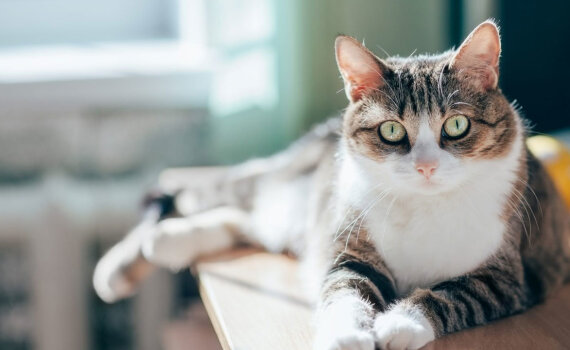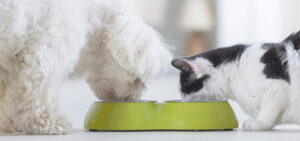
Environmental Enrichment for Indoor Cats: Maximizing Your Home to Better Meet Your Cat’s Needs – Part 1
Category:CatsPart 1: Fundamentals and Food and Water.
by Ingrid Johnson, CCBC (Certified Cat Behavior Consultant)
Fundamentally Feline
“Environmental enrichment is a concept which describes how the environments of captive animals can be changed for the benefit of the inhabitants. It is a dynamic process in which changes to structures and husbandry practices are made with the goal of increasing behavioral choices to animals and drawing out their species appropriate behaviors and abilities, thus enhancing animal welfare.”1
Humans have created a world that is no longer safe for cats. We can choose to let our beloved cats go outside, where they can be hit by cars, attacked by dogs or wild animals, shot with pellet guns, and live a life threatened by diseases and parasites, or we can keep them safely indoors. But that safety comes with a price doesn’t it? We force cats to comply with the expectations of the human world, and that often sets them up to fail.
Enrichment can help change that by setting them up for success, but enrichment is more than just providing toys. Our homes are essentially glorified cages. We must strive to make our homes — our cats’ “cages” — the most fun and stimulating places they can be by meeting all of our cats’ needs while keeping them safe.
In order to meet our cats’ needs, we need a better understanding of what exactly those needs are. Cats thrive on predictability and routine. They like to feel in control of their surroundings and of resources such as food, water, litter, vertical space, and safe napping spots. Their species is both predator and prey, so the needs of both must be met. That means providing places to retreat that create a sense of safety and security while simultaneously appealing to their hunting instincts and prey drive.
This is where play and positive frustration come in. “Positive frustration” refers to situations in which the animal has to figure out a problem and is rewarded when they do so.2 An example would be the process of hunting — figuring out how to catch prey so that they can eat. In the home setting, foraging toys, also referred to as food puzzles, can be used to mimic this predatory drive and create positive frustration. Of course, play time with both interactive and solo object toys as well as interaction with other cats, dogs, and humans can also be enriching and desirable to different extents, depending on the individual.
Food and Water
Cats are not family-style eaters,3 yet humans seem to insist on lining up all of our cats’ bowls in the kitchen and forcing them all to eat together. This is not an ideal way to feed cats. In fact, it is a great way to create unnecessary competition, increase aggression between cats, and cause someone to go without their portion of canned food. Meal feeding and family-style eating creates competition that often results in enthusiastic overeating, which can lead to vomiting. Cats naturally eat nine to 16 small, evenly sized meals throughout the course of the day.4 They are grazers. Rather than creating so much competition at meal time, create feeding stations that allow them to graze on canned food the way they have previously grazed on dry kibble. This allows the cats to eat in the locations and at the times that they feel most comfortable.
Try to maintain a consistent schedule of feeding and play, as cats are extreme creatures of habit who thrive on routine. It is especially important to maintain schedules in the face of environmental stressors such as houseguests, moving, bringing home a new baby, etc.
Another tip is to separate food and water. In the wild, cats would not normally have a water source right next to where they killed their prey, so it is more natural for them to have their water separated from their food. (Both should also be separated from their litter.) Cats can be very finicky about the taste of their water. Putting food and water bowls close together often results in food particle contamination, which distorts the taste of the water, resulting in less drinking. If you have a dog, always offer a separate water source for your cat. While they may choose to drink from the dog’s bowl, they may also want to avoid the doggy slobber. Be sure to offer options.
While we are on the subject of water, let’s have some fun! Some cats really do enjoy playing with water — on their terms, of course. Try placing some marbles on the bottom of a bathroom sink filled with water so your cat can “go fishing” for them. This game can be very fun because the marbles are quite slippery, and actually getting one out of the sink is quite a challenge. I place a towel on the edge of the sink to help absorb any mess from this game. If your cats are leery of actually sticking their paws into the water, try ping-pong balls. They float on top and bounce around a bit. You can also try children’s wind-up toys; the only downside is that you often have to stick around to keep winding them up. Another fun option is making flavored ice cubes. Tuna water or low/no sodium chicken broth can be great for this. I usually put a little piece of meat in the center so they get a treat when it melts, like a Tootsie Pop! These ice cubes can be placed in sinks, bathtubs, sheet pans, or even dropped into water bowls to flavor the water. However, if you are going to do this, you MUST provide a regular unflavored water source as well.
Offering dry food in food-dispensing toys, also called foraging toys or food puzzles, is a great way to allow your cats to free feed and eat their normal nine to 16 small meals per day while also giving them something fun to do with their time. Foraging toys provide an outlet for cats’ hunting instincts and prey drive. These toys offer positive frustration; when cats figure out the puzzle, they are rewarded with food. This style of free feeding also solves the problem of excessive overeating that often results in the vomiting of undigested food. I have seen foraging reduce aggression in multi-cat homes because the cats have to spend more time figuring out how they are going to acquire food and eat, so they have less time to beat up their house mates. More mental stimulation leads to less environmental stress!3 For cats who are new to foraging, toys should be clear and round with multiple holes. Clear objects allow them to see the kibble; round means the toys will roll easily, and objects with multiple holes will dispense the kibble easily so your cat can be successful and learn the game. As they start to get the hang of manipulating the toys, try offering opaque objects so that the food inside can no longer be seen. Next, try toys with erratic movement or those that do not roll very easily. The ultimate goal is to find your cat’s greatest level of challenge. This will, of course, be different for each individual. I have found opaque, cube-shaped toys and weighted toys to be the most difficult. Some cats I refer to as “master foragers” eventually end up hilling a wall and can get easily food out of just about anything. For these individuals, try combining toys by filling a smaller object and placing it inside a larger one.
Next month we will continue with Part 2, which will cover environmental enrichment for indoor cats relating to Litter Boxes, Vertical Spaces and Scratching.
Citations
- Young RJ. Environmental enrichment for captive animals. Oxford: Blackwell Science; 2003:1-2.
- Neville PF. An ethical viewpoint: the role of veterinarians and behaviorists in ensuring good husbandry for cats. Paper presented at: American Association of Feline Practitioners; 2002; Tempe, Arizona.
- Overall KL. Manual of clinical behavioral medicine for dogs and cats. St Louis: Elsevier;201 3:106-9.
- Beaver RVG. Feline behavior A guide for veterinarians. 2nd ed. St. Louis: Saunders Co; 2003:54, 221.
Part 2: https://www.mistypinespetcompany.com/environmental-enrichment-for-indoor-cats-maximizing-your-home-to-better-meet-your-cats-needs-part-2/
Part 3: https://www.mistypinespetcompany.com/environmental-enrichment-for-indoor-cats-maximizing-your-home-to-better-meet-your-cats-needs-part-3/







